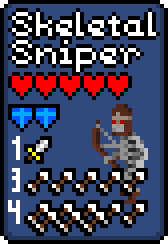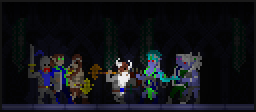In the first update, I posted a glimpse at the Dark Dwelling, the first-tier home of Tomb of Tyrants's Dark Elves. There are currently eight first-tier floors in the game, and they lay the foundation for your build path, each opening up new floors and upgrades. However, every entry-level floor conflicts with one of the others, so you can only build four per game.
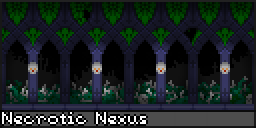
The Dark Dwelling's alternative floor is the Necrotic Nexus, a starting structure for necromancers. It potentially leads to virulent curses and powerful undead, like liches--or even dracoliches. The Dark Dwelling, on the other hand, builds toward nameless magics, eldritch horrors, and probably spider demons. The more content is added, the more complex these paths and options will become, as advanced floors shape the output of one another.
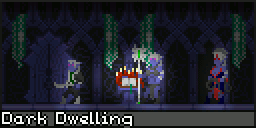
The Dwelling produces Dark Elf warriors from the start, but it also grants build access to the Abyssal Altar, which generates Dark Elf spider priestesses. Additionally, the Dwelling can be upgraded by a later floor to produce a Dark Elf Matriarch, an imposing, whip-wielding sorceress.
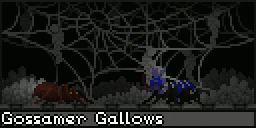
The Gossamer Gallows is a second-tier floor that serves up giant spiders. It first requires you to build the Grotesque Grotto (Goblins), Warped Warrens (Kobolds), or Seedy Cellar (ROUS), as these eight-legged friends are attracted by small, savory critters (don't worry, your spiders will not actually eat your other minions). Just as the Dark Dwelling can be upgraded, it, too, can bestow upgrades; building the Dark Dwelling will upgrade the Gossamer Gallows to offer spidertaurs, half-spider Dark Elves with large, chitinous frames and the ability to use various weapons.
Each battle in Tomb of Tyrants is a real-time, turn-based, four-on-four encounter. The game never pauses for battles, but characters do take turns performing primary and secondary actions. Aside from initial combat order, there are no random elements, making combat largely deterministic--this means, given experience, players should have a reliable notion of which way an encounter will go.

During an encounter, combatants line up and take turns exchanging blows. On offense, each character has the opportunity to use an ability that corresponds to their position in line (if they have such an ability); the lead character will use their primary ability, the next character will use their secondary, and so forth. Many characters have only a primary or secondary ability, and most of these are offensive attacks designed to target the person at the front of the enemy line. However, they can include area attacks, friendly buffs, and more. After the offensive team has taken its turn, the first character will incur a fatigue point (more on that in a moment) and move to the back of the line, shuffling the rest of their team forward and handing the offensive turn over to the other team.

On any given turn, the game displays the health of both sides—highlighting the health of the current line leaders—and the offense and defense of the current attacker and defender. The attack icons can vary in appearance based on the type of attack being performed (melee, ranged, fire, poison, etc.), but when their owner strikes, these icons will always assault their opponent's health and defense. Active shield icons will reflect an equal amount of the incoming damage, but any damage that gets through will claim one of the highlighted hearts.
Characters fatigue after each primary turn, which reduces their defense by one point (represented by a red "x" shield). This prevents deadlock between characters with high armor and low attack ratings, and makes it possible for exceptionally powerful creatures to be worn down by prolonged encounters.

It also means that solo characters are much weaker on their own, because without any friends, they will be forced to take repeated turns, quickly dropping their defenses. Most primary abilities are melee attacks, but many secondary ones are utility-oriented, such as a cleric's healing spell. Without a party, that cleric would only ever be able to use their primary attack, because they will never be in the secondary slot. Early in the game, adventurers are more likely to trickle down in small, isolated numbers, but once they start partying up, even inexperienced heroes can become a considerable threat. Furthermore, because encounters are limited to four-on-four per floor, a full encounter allows extra heroes and minions alike to roam freely through the background of a floor--heroes will not cease their descent and wait for a pitched battle.
Although the core mechanics are simple, there is a lot of room for depth here, even without considering immunities (complete resistance to a type of attack), weaknesses (allowing a type of attack to ignore defense), or other traits (like trigger-able abilities). Consider, for instance, a sniper who can only use their powerful bow from the range of the tertiary or quaternary position. In the primary slot, they may be forced to use a pitiful melee attack. Coupled with low health and defense, this character would never survive well on its own, but it quickly becomes a deadly adversary when thrown into a party with a couple fighters and a cleric—or skeletal warriors and a necromancer:
